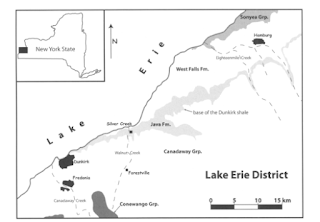
History of Oil Finders Friday: Dunkirk Black Shale Gas Well, 1825, in Fredonia, New York
Author: susan smith nash
Source
In the 1820s in Fredonia, New York, William Aaron Hart, a local gunsmith long curious about the gas seeps emanating from the nearby Canadaway Creek, decided to investigate. According to a historical report, he first tested the gas by collecting it in a flipped-over washtub, inserting a gun barrel in a hole, and then lighting the gas as it flowed through the gun barrel.
Encouraged, Hart started to investigate the origin of the gas seeps, and soon found that they were coming from what he referred to as “slaty rock,” which was later classified as the Dunkirk shale, an upper Devonian black shale, typified by prominent and numerous joints and fracture networks. Early geologists such as Lewis Caleb Beck (1798-1853) studied not only the geology and mineralogy, but the surrounding vegetation as well.
The Dunkirk shale is a very low-permeability source rock which reached the oil window for hydrocarbon generation during the Permian. Heat flow occurred at the same time that the tectonic events were propagating the joints throughout the Devonian section in the Finger Lakes District (Lash, 2014). In other words, Gary Lash and his fellow researchers found that petroleum generation was a joint-driving mechanism, due to thermally-driven phase change.
Randy Blood, who studied under Gary Lash, has continued to do extensive fieldwork and to make further connections between thermal maturation and the development of massive joint systems which create a robust and persistent gas reservoir and migration pathway. The exploration implications are significant. 
Gas generation from the upper Devonian black shales resulted from the desorption of methane from the surface of residual organic material (kerogen and bitumen) and clay minerals, principally illite. Production, however, depends the size, frequency, and interconnectedness of natural jointing.
After continuing to investigate and experiment, in 1825 Hart drilled a 27-foot hole into the rock, and encountered gas that would flow at a rate sufficient for him to invent and implement a small pipeline (first made of bamboo) and to use the gas in gas lamps, first in farms, a mill, and later in a hotel and a lighthouse.
Several years later, Preston Barmore, a creative engineer unfazed by what might happen as one ramped up the production volumes of natural gas, decided to drill a well to 127 feet in depth, and, when frustrated by the low volume of gas, decided to ignite the gas, causing downhole explosions (Martin, etal, 2008). This early version of fracing was highly effective.
Within a few years, hundreds of wells were drilled in the shallow Dunkirk shale, and pipelines were constructed to distribute the gas to street lamps, making Fredonia one of the first towns in the world to have gas street lamps (Martin, et al, 2008). Other pipelines were built in western and upstate New York, including ones constructed of hollowed-out tree logs, used for transporting produced salt water to evaporation ponds.
Whether or not the shallow, low-volume gas reservoirs of the Dunkirk shale might still have economic potential given current regulatory frameworks is something to be pursued. Because there were so many active gas seeps in the past, it might be worthwhile to conduct airborne surveys to detect methane and to see if there are any concentrations around natural seeps. There could be local uses for low-volume gas for innovative geologists and engineers today as well as almost 200 years ago.
References
Blood, R., and Lash, G. (2019). Horizontal Targeting Strategies and Challenges: Examples from the Marcellus Shale, Appalachian Basin, USA. Conference: Unconventional Resources Technology Conference (URTeC),2019 – Denver, CO. https://www.researchgate.net/publication/334812445_Horizontal_Targeting_Strategies_and_Challenges_Examples_from_the_Marcellus_Shale_Appalachian_Basin_USA
Lash, G., Loewy, St., and T. Engelder (2004). Preferential jointing of Upper Devonian black shale, Appalachian Plateau, USA: evidence supporting hydrocarbon generation as a joint-driving mechanism. Geological Society of London. Special Publications. Vol. 231:1, p 129-161.
Lash, G. G., and E. P. Lash (2014) Early History of the Natural Gas Industry, Fredonia, New York. Search and Discovery Article. August 29, 2014. https://www.searchanddiscovery.com/pdfz/documents/2014/70168lash/ndx_lash.pdf.html
Lash, G., and E. Lash (May 2015) The Unsung “Father of the Natural Gas Industry” AAPG Explorer. May 2015. https://explorer.aapg.org/story/articleid/19706/the-unsung-father-of-the-natural-gas-industry
MacDonald, Ronald (2002) Application of Innovative Technologies to Fractured Devonian Shale Reservoir Exploration and Development Activities, Proceedings of the Forty-First Annual OPI Conference, Ontario Petroleum Institute, November 4-6.
Martin, J P., Hill, D. G., Lombardi, T. E., Nyahay, R. (2008). A Primer on New York’s Gas Shales. New York State Geological Association: NYSGA Online. https://www.nysga-online.org/wp-content/uploads/2019/06/NYSGA-2008-A1-A-Primer-on-New-Yorks-Gas-Shales.pdf


